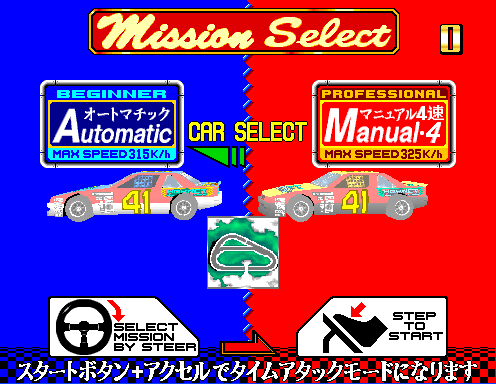

Here is where its easiest to mess up if you haven’t gotten down how to turn, how much speed to have when turning, and whether or not you want to drift the corner or try to approach it more carefully. While NASCAR theming is so prevalent here that there’s a completely pointless Pit Stop area with an associated animation that just burns precious time, near the hardest turn on the track there are multiple gambling related signs and a large mountain bearing Sega’s mascot Sonic the Hedgehog. You have to make sure your turning isn’t too deep or too shallow when you start reaching the most ornate part of the track. Driving in Daytona USA might not quite feel realistic, but there is a subtlety to how you use the directional pad to take turns, the car sliding if you’re too sharp and micro-adjustments sometimes a smart move. Given the slight hint of a triangular shape, the track has a few moments of speed-building straightaways and a few lingering turns that ask you to approach them properly. It’s essentially one big loop, but it’s thankfully not just a straightforward oval. The Beginner track is the Three-Seven Speedway, a course based on real NASCAR tracks and thus quite simple for it.

Sorted into Beginner, Advanced, and Expert designations, they do all feel quite distinct from each other at least and come in mirrored versions to play as well. One hard to pill to swallow for any prospective player of Daytona USA is that the game only features three unique race tracks. Racing games are often a graphical benchmark for a system and sadly Daytona USA made Sega look bad with its showing, but that doesn’t necessarily mean it failed as a racing game in general. Despite being billed as a tentpole title for the system, it had a major graphical downgrade from its arcade counterpart, and compared to the original PlayStation’s port of rival Ridge Racer, Daytona USA made Saturn look weaker when it was already flagging in the sales race. The library for the system is still well-regarded, but one of its most remembered releases, Daytona USA, actually reflected poorly on the console despite its popularity. Positioned between the kingmaker that was the Genesis and the beloved underdog that is the Dreamcast, Saturn sort of embodies the decline of Sega as they struggled with how to push forward beyond the 16-bit era. The Sega Saturn may not be the most obscure piece of hardware from Sega, but it certainly feels like the black sheep of the bunch.


 0 kommentar(er)
0 kommentar(er)
